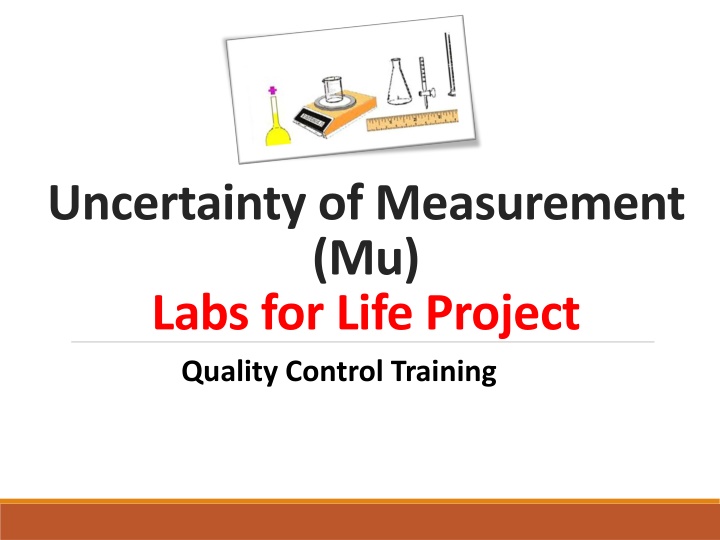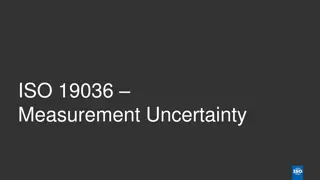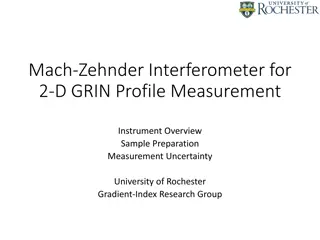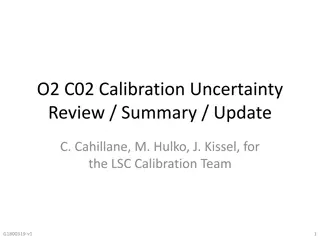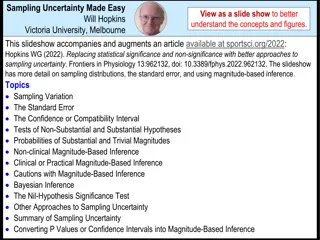Uncertainty of Measurement in Labs for Life Project Quality Control Training
The Uncertainty of Measurement (Mu) is crucial in quality control training for clinical laboratories. Explore key points, uncertainties, and why MU matters in routine clinical settings. Discover the analytical components involved and how to calculate MU effectively within the Gaussan distribution.
Download Presentation

Please find below an Image/Link to download the presentation.
The content on the website is provided AS IS for your information and personal use only. It may not be sold, licensed, or shared on other websites without obtaining consent from the author.If you encounter any issues during the download, it is possible that the publisher has removed the file from their server.
You are allowed to download the files provided on this website for personal or commercial use, subject to the condition that they are used lawfully. All files are the property of their respective owners.
The content on the website is provided AS IS for your information and personal use only. It may not be sold, licensed, or shared on other websites without obtaining consent from the author.
E N D
Presentation Transcript
Uncertainty of Measurement (Mu) Labs for Life Project Quality Control Training
What is uncertainty of Measurement? Uncertainty - Not a Doubt of Validity Assertion of Confidence 3% uncertainly translates as 97% CONFIDENCE !!
ISO 15189:2012 Says. 3 2/24/2025 QC TRAINING- LABS FOR LIFE PROJECT
5 key points to note Uncertainty of Examination phase To be reviewed periodically Using Control material Through Intermediate precision Applications: 1. Monitor Quality Goals 2. Comparison of patients values with previous reports 3. Comparison of patients values with clinical decision levels 4 2/24/2025 QC TRAINING- LABS FOR LIFE PROJECT
What are the uncertainties? 5 2/24/2025 QC TRAINING- LABS FOR LIFE PROJECT
Variations within an individual: Pre-pre analytical!! 6 2/24/2025 QC TRAINING- LABS FOR LIFE PROJECT
Start here MU calculable is just this 7 2/24/2025 QC TRAINING- LABS FOR LIFE PROJECT
Can be here or anywhere in the Gaussian Can be here or anywhere in the Gaussian 8 2/24/2025 QC TRAINING- LABS FOR LIFE PROJECT
Analytical Components Analytical: Reagent Calibrator Operator Equipment Environment 9 2/24/2025 QC TRAINING- LABS FOR LIFE PROJECT
10 2/24/2025 QC TRAINING- LABS FOR LIFE PROJECT
Why does MU matter in routine clinical laboratories? Clinicians compare most measurement results with reference values and with previous results from the same patient Variability in repeats confuse clinicians 11 2/24/2025 QC TRAINING- LABS FOR LIFE PROJECT
Why does MU matter in routine clinical laboratories? Some analytes have very narrow range, example therapeutic ranges for drugs; narrow effective range between insufficiency and toxicity Some analytes have sharp cut-offs making clinical decisions difficult 12 2/24/2025 QC TRAINING- LABS FOR LIFE PROJECT
Why does MU matter in routine clinical laboratories? MU can also be an indicator of the Quality Assurance of the laboratory, conveyed to its users However, MU has more to do with interpretation of the reports than monitoring of the analytical system 13 2/24/2025 QC TRAINING- LABS FOR LIFE PROJECT
How can you measure Uncertainty Points to remember We are trying to capture only analytical uncertainty How can you measure the uncertainty of the result of an analyte, say glucose? If the dispersion in the glucose could be repeatedly analyzed over a period of time, say over 20 day that SD could indicate the degree of uncertainty Since it is not practical to do that, how else can one conclude the degree of uncertainty? 14 2/24/2025 QC TRAINING- LABS FOR LIFE PROJECT
How can you measure Uncertainty What material is available in the lab for repeated examination? Internal Quality Controls! Look at the degree of dispersion, standard deviation, of glucose at the corresponding level. The data from the Internal Quality Controls (with which we monitor the analytical phase), reflects the degree of uncertainty This number can be informing that to the clinician 15 2/24/2025 QC TRAINING- LABS FOR LIFE PROJECT
Concepts in Precision: Concepts in Precision: To arrive a number to specify as the degree of dispersion, ISO recommends Intermediate Precision. There are 3 concepts in Precision 1) Repeatability 2) Intermediate Precision 3) Reproducibility 16 2/24/2025 QC TRAINING- LABS FOR LIFE PROJECT
Repeatability Repeatability: is precision when using Same operators Same measuring system Same operating conditions Same location Over a short period of time. Repeatability is expressed in terms of standard deviation. Within-run/ Intra-serial/Intra-run precision condition are synonyms 17 2/24/2025 QC TRAINING- LABS FOR LIFE PROJECT
Reproducibility Reproducibility Reproducibility : is precision when Test results are obtained with the same method By different operators Using different equipment In different laboratories On different days. Reproducibility is expressed in terms of standard deviation but will be considerably larger deviations than Repeatability Between Laboratories/ Inter Laboratory/Among Laboratories are synonyms 18 2/24/2025 QC TRAINING- LABS FOR LIFE PROJECT
Intermediate Precision: Intermediate Precision: Intermediate Precision: Is something between the 2 states, One lab With changes of reagent Changes of calibrator lots Changes of operators Changes of operating conditions All acceptable laboratory variables will be captured if at least 100 measurements are included. Intermediate Precision is expressed in terms of multiples of the standard deviation The Uncertainly of Measurement (MU) uses intermediate precision as the basis for its calculation 19 2/24/2025 QC TRAINING- LABS FOR LIFE PROJECT
Repeatability Intermediate Precision Reproducibility 20 2/24/2025 QC TRAINING- LABS FOR LIFE PROJECT
Using mathematical Models to Estimate MU 2 Estimates of MU: Combined MU and Expanded MU Ideally the MU should capture all the elements of uncertainty In practice, MU is concerned with only analytical uncertainty (Biological and Pre and post analytical uncertainties are not included) Within the analytical uncertainty itself, those arising from systematic effects that contribute to the error are not included (Only SD is considered). The calculations of MU assumes that the bias cannot be estimated correctly and hence is not considered in the estimate of MU To circumvent all of the above, Uncertainty of a Measurement result is usually evaluated using a mathematical model using the law of propagation of uncertainty 21 2/24/2025 QC TRAINING- LABS FOR LIFE PROJECT
Combined MU Combined MU ( c): Most measurement procedures MU is simply the Intermediate Precision assessed using QC, usually expressed as 1 SD or CV % Why is it called combined?? All acceptable laboratory variables (intermediate precision) will be captured if at least 100 measurements are included. All these are combined and reflected in such an SD. 22 2/24/2025 QC TRAINING- LABS FOR LIFE PROJECT
99.7% 95% 68% 13.5% 2.5% 34% 34% 13.5% 2.5% 2/24/2025 23 QC TRAINING - LABS FOR LIFE PROJECT
Expanded MU To have 95% of possible values covered, expanded uncertainty is used with a coverage factor of 2 2* c which can be 2 * SD = U Or 2* CV = U 24 2/24/2025 QC TRAINING- LABS FOR LIFE PROJECT
Coverage factors and confidence limits Applying the following coverage factors will offer the corresponding confidence limits: k=1.00 ----68.27% k=1.64 ----90% k=1.96 ----95% k=2.00 ----95.45% k=2.58 ----99% k=3.00 ----99.73% (GUM 6.3.3) 25 2/24/2025 QC TRAINING- LABS FOR LIFE PROJECT
Expanded MU at CDPs If several levels of QC are used the MU should be calculated for each Judgment made as to whether they are sufficiently different to warrant their use with patient results 26 2/24/2025 QC TRAINING- LABS FOR LIFE PROJECT
Review of MU (NABL 112) It is recommended that a minimum of six months internal QC data should be used to calculate routine imprecision, To be updated annually For non quantitative set of tests, the laboratory shall enlist the factors which could contribute to the uncertainty of the results and also ensure that they were given due attention while performing the test. 27 2/24/2025 QC TRAINING- LABS FOR LIFE PROJECT
Some examples: Clinical Decision Therapeutic Range of Digoxin is 0.9-2 ug/mL. Your lab is reporting a level of 1.8 with a SD of 0.2 ug/mL. Does the clinician need to know this? Does the clinician have to cut the dose? 1.8 +/- 0.4 = The actual result could be 1.4 2.2 ug/mL 28 2/24/2025 QC TRAINING- LABS FOR LIFE PROJECT
Some examples: Clinical Decision ADA cut off for Gestational Diabetes FBG is 92 mg/dL. You have a report of 90 mg/dL and a CV of 3%. Does the obstetrician need to know? Will there be consequences? 90 +/ - 6% = 84.6 - 95.4 29 2/24/2025 QC TRAINING- LABS FOR LIFE PROJECT
Some examples: Comparison with previous results Some examples: Comparison with previous results Assume this is patient with a chronic liver disorder. Assume this is patient with a chronic liver disorder. What are you conveying? Is the patient responding What are you conveying? Is the patient responding to treatment or worsening or is it status quo? to treatment or worsening or is it status quo? 30 2/24/2025 QC TRAINING- LABS FOR LIFE PROJECT
Should MU be routinely reported to clinicians? oNot Required on the reports oShould be available if requested oClinicians should be made aware of the concept 31 2/24/2025 QC TRAINING- LABS FOR LIFE PROJECT
5 key points, Recap Uncertainty of Examination phase To be reviewed periodically Using Control material Through Intermediate precision Applications: 1. Monitor Quality Goals 2. Comparison of patients values with previous reports 3. Comparison of patients values with clinical decision levels 32 2/24/2025 QC TRAINING- LABS FOR LIFE PROJECT
Thanks 33 2/24/2025 QC TRAINING- LABS FOR LIFE PROJECT
